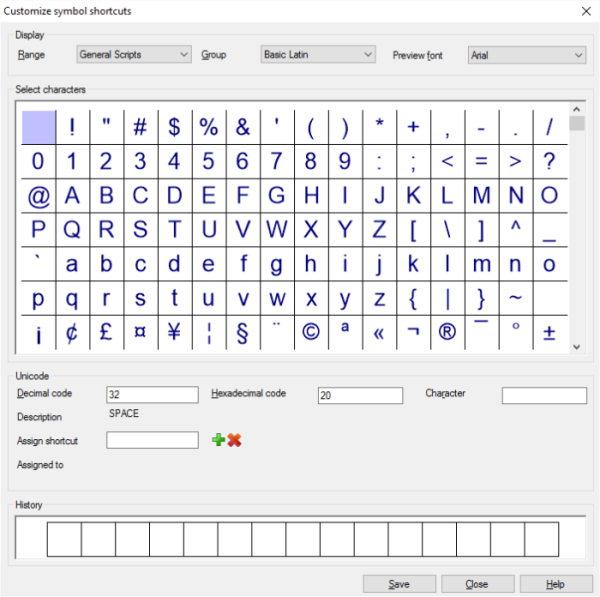Customize symbol shortcuts
If you need to insert a character that's not on your keyboard, you use the Insert symbol or the Insert Special Character command (on the Edit ribbon). But if there are characters you need to use often, it's much quicker to use keyboard shortcuts for those.
In a keyboard shortcut set, you can include shortcuts for symbols and special characters, too.
When you customize a keyboard shortcut set, you can open the Customize symbol shortcuts window to include these symbols.
How to get here
- On the Quick access toolbar (in the top left corner of the memoQ window), click Options
 .
. - In the Options window, choose Keyboard shortcuts. In the list, select a keyboard shortcut set. Click Edit. The Customize memoQ shortcuts window appears.
Can't edit the Default shortcut set: If the list has the Default shortcut set only: Select it, and click Clone. Clone it or create a new one before editing. The Clone keyboard shortcut set into a new resource window appears. Type a name for the new shortcut set. Click OK. In the Keyboard shortcuts list, select the new shortcut set. Click Edit.
- At the bottom of the Customize memoQ shortcuts window, click Special characters. The Customize symbol shortcuts window appears.

What can you do?
- Choose the character:
Find the character in the Select characters grid. When you find it, click it.
If you can't find it: Try a different range, a different Unicode group, or a different font to view them.
- In the Range drop-down box, memoQ offers four categories: General scripts, Symbols, Miscellaneous, and Chinese, Japanese and Korean.
- To refine this more, choose a Unicode group directly, from the Group drop-down box.
- Finally, if you suspect that the current preview font can't show the character: In the Preview font drop-down box, choose a different font.
Or, specify the character by its code. Simply type the Unicode number in the Decimal code or in the Hexadecimal code box. Most of the time, Unicode numbers come in hexadecimal code.
Or, use a recent character: Find the character in the History grid, and click it.
- Assign the shortcut:
- Click the Assign shortcut box. Press the keyboard shortcut.
- Click the plus sign next to the box.
Careful with shortcuts that are already taken: If the shortcut you press is already assigned to another command or symbol, and you save it nevertheless: It will be removed from the original command or symbol.
When you finish
To save the changes to the shortcuts, and return to the Customize memoQ shortcuts window: Click Save.
To return to the Customize memoQ shortcuts window, and not save the new shortcuts: Click Close.
Don't forget to activate the new shortcuts: After you save the symbol shortcuts, save the shortcut set from the Customize memoQ shortcuts window, too. Then the Options window returns. In the Keyboard shortcuts pane, select the checkbox of the shortcut set you just customized. The new shortcuts will work all over memoQ, in every project.